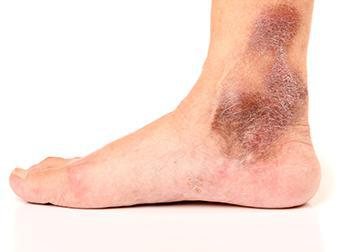What Is A Venous Leg Ulcer?
A venous leg ulcer, also known as stasis, insufficiency, or varicose ulcer is a common type of chronic wound that occurs due to poor blood circulation in the limb. It usually takes more than six weeks to heal as the veins in the legs are insufficient to carry blood back to the heart, causing increased pressure in the veins. In other words, a venous ulcer is caused by a malfunctioning of venous valves. It typically occurs on the legs or foot and can last anywhere from a couple of weeks to years. If not treated on time, the increased pressure and the excess fluid in the veins can result in an open sore in the affected area. But how to recognize if a patient has a venous ulcer?
What Are The Symptoms/Signs Of Venous Ulcer?
Due to the excess blood in the veins of the lower leg, fluid and blood cells drain out into the skin and other tissues. It can lead to itchiness, thin skin, and skin discoloration, known as “stasis dermatitis”. This could be an early symptom of a venous ulcer.

Other symptoms of the venous ulcer include:
- Swelling
- Pain
- Rash or dry skin
- Foul odor from the affected area
- Hardened skin around the affected area
- Fever
- Pus
- Leg cramps
- Brown discoloration etc.
Infection
A venous ulcer is prone to bacterial infection. Symptoms of an affected leg ulcer include:
- Pain
- Bad odor
- High temperature
- Pus drainage from the wound etc.
If a patient sees any of these symptoms, he/she needs to immediately contact venous ulcer treatment specialists. The expert team of doctors, nurses, and physicians evaluate the condition of the wound, and depending on the diagnosis, they generate a personalized treatment focused on the patient’s individual needs.
Who Gets Them?
Risk factors for developing a leg ulcer include:
- Obesity
- Smoking habits
- Long time immobility can lead to a weakened calf muscle
- Swollen veins caused by malfunctioning valves
- Any previous injury to the leg, such as broken or fractured bone
- Diabetes (due to poor blood circulation and an increased risk of a pressure ulcer)
- Increased age
- Peripheral arterial disease
- Other circulation issues such as blood clots, or phlebitis, etc.
- Pregnancy etc.
If patients are suffering from any of these conditions, they need to discuss the preventive measures with venous ulcer specialists in California.
What Causes Venous Ulcer?
A venous ulcer occurs due to a break in the skin on the leg, typically around the ankle. When the veins in the legs are not capable of sending blood back to the heart, it causes increased pressure at the end of the limb. This is known as “Venous Insufficiency”. The increased pressure and buildup of fluid prevents oxygen & nutrient-rich blood from getting to tissues. The lack of nutrients further leads to weakened skin and a slow wound healing process for any cuts or scrapes.
Thereby people with old age are at more risk of developing a venous ulcer. They tend to have venous insufficiency and the fragile skin is more prone to develop a sore.
How to Diagnose Venous Ulcers?
If any patient has possible signs of a venous leg ulcer, they must consult with the venous ulcer in Ventura County. To diagnose whether a patient has a venous ulcer, the doctors usually conduct a quick physical examination of the sore and the surrounding skin to look for any symptoms. They may also ask for previous medical records to know the history of ongoing chronic conditions, if any, such as diabetes, or hardened arteries. In some cases, the team of doctors might conduct other tests, such as an X-ray, or a CT scan, to evaluate veins and the surrounding area to get more details. Sometimes, an ulcer can cause other issues, including severe skin and bone infections.
Other Diagnostic Tests:
- Ankle-Brachial Index (ABI) to determine if there is also arterial insufficiency
- Doppler ultrasonography
- Doppler bidirectional flow studies
- Venography
How To Treat Venous Ulcer?
The treatment for venous ulcers focuses on mitigating complications, such as tissue edema, pain, and wound site infections. Here are the key strategies for venous ulcer treatment:
- Wear compression stockings or bandages every day as instructed by venous ulcer San Diego. The pressure will help improve blood circulation in the legs and speeds up the body’s ability to heal the wound.
- Walk regularly. Immobility can worsen the ulcer and associated symptoms such as edema. Raise legs for set lengths of time to improve circulation.
- In case of bacterial infection, the patients may be given antibiotics. The doctors may also ask to cover the wound with a moist dressing to help it heal more quickly.
- Surgery may be required in some cases.
Apart from the treatment, the patients must consult preventive measures with wound care doctors to mitigate the chances of development of venous ulcer such as:
- Quit smoking
- Lose weight
- Treatment of chronic conditions such as high BP or diabetes
- Reduce salt intake
- Exercise daily etc.
